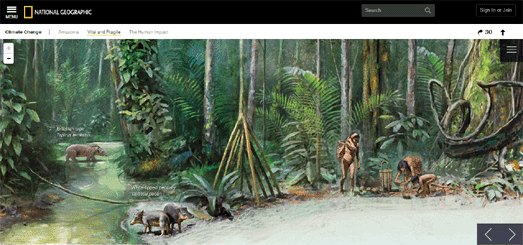
The deforestation of the Amazon rainforest in Brazil last year reached its highest rate for ten years. Nearly 8,000 sq km of rainforest was destroyed between August 2017 and July 2018. The Brazilian government says that illegal logging is to blame for the huge rise in deforestation. The future outlook for the Amazon rainforest looks to be even worse. The newly elected president, Jair Bolsonaro, has promised to lower fines for illegal logging and to reduce the power of the government's environment agency.
You can view how logging has affected the size of the rainforest on TerraBrasilis PRODES.
TerraBrasilis PRODES is produced by the Brazilian National Institute for Space Research (INPE) to visualize its environmental monitoring data. Since 1998 the PRODES project has been monitoring, by satellite, deforestation in the Amazon region and has published information on the annual deforestation rates.
The interactive TerraBrasilis PRODES map allows you to view the accumulated areas of the Amazon which have been affected by deforestation between 1988 and 2012. It also allows you to view the yearly deforested areas for each separate year from 2013 to 2018. If you click on the pie chart icon on the map you can view the yearly deforestation rates in the Brazilian rainforest in a series of charts and graphs. A table view also allows you to view the annual deforestation rate in each state in the country and for Brazil as a whole.

If you are interested in the future of the Amazon rainforest then you should refer to Infoamazonia's interactive
Forest Cover Through Time map. This map shows Infoamazonia's projections for the extent of the rainforest's cover up until it is almost completely destroyed (which it predicts will occur in the year 2260). Just select the date buttons above the map to view the projected forest cover for any specific year.
Illegal logging isn't the only cause of deforestation in Brazil. The
Silent Forest project has been started by a team of Brazilian and foreign scientists to assess the extent and impact of forest degradation in the Amazon rainforest. As a result of this monitoring the project has released an interactive map to show
Contributing Factors to Degradation in the Brazilian Amazon Rainforest. The map shows the extent to which fire, logging, hunting and fragmentation are all leading to the destruction of the rainforest in Brazil.
You can learn more about the Amazon rainforest on National Geograhic's Amazonia Under Threat.
Amazonia Under Threat explores the various ecosystems which once thrived in the rainforest. It also maps the effect that people and human industry are having on the delicate ecosystems of the Amazon region.



















































